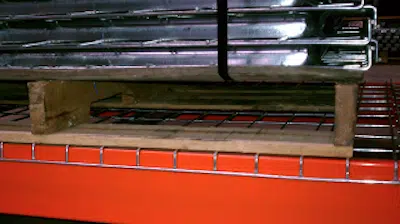Material Handling Safety Best Practices
According to a study published in 2011, occupational injuries and illness combined to cost the U.S. about $250 billion in 2007. While it’s now 11 years later and safety processes and products are always improving, it’s safe to say whatever the cost is now is still pretty high. Although regulatory agencies such as OSHA exist to make workplaces safer, it’s ultimately the responsibility of the company, its management, and its employees to actually cultivate warehouse safety.
Although it’s an essential part of responsible and productive warehouse operations, following warehouse safety best practices is sometimes easier said than done. There’s a lot to keep track of, and standards are always evolving. To stay on top of specific warehouse safety standards, there are excellent tools to bookmark, like OSHA’s Warehouse Safety Pocket Guide and the RMI Safety Blog, to name just two. Along with the specific safety standards set forth by organizations like OSHA and RMI, it’s also helpful to keep general guidelines and rules of thumb handy for reference.
In our now almost two decades as a material handling business, we’ve learned a lot about safety in warehouse storage and practical ways to make working with material handling equipment safer. As part of our overall goal to help you, the dealer, we’ve condensed and curated many of the safety topics we’ve learned and written about into a guide to warehouse storage safety. We hope it comes in handy when conducting a safety audit or making recommendations to a customer for how they can make their warehouse a safer place for their employees.
Warehouse Safety: Pallet Racking
Pallet Rack Maintenance Plan
Unlike a roller coaster or a Boeing 747, pallet rack systems don’t have thousands of complex moving parts. But don’t let that fact lull you into thinking pallet racking is maintenance-free. Like any piece of heavy equipment, pallet rack systems need to be inspected, according to RMI, at least annually. It’s easy to overlook damage done by small collisions or the disrepair that can accumulate with years of use. Better to make pallet rack inspections a habit and not wait until the racking is compromised.
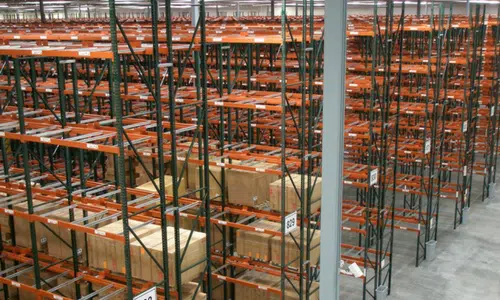
Pallet Rack Backing and Safety Netting
Storing heavy items several stories in the air doesn’t come without risk. That’s why pallet rack backing and safety netting are popular accident prevention tools in the modern warehouse. While rack backing and safety netting have some differences, both serve a common purpose: keeping inventory from falling off load beams.
Pallet Rack Capacity Labels
Pallet racking can hold a lot of weight, but it’s not indestructible. Overloading pallet rack is dangerous and should be avoided at all times. But if you’re a lift truck operator and your goal is to stay within your pallet rack’s capacity rating, you’ll first need to know what that rating is. That’s where capacity labels come in handy. If you’re the owner of the racking and don’t know what its capacity is, we recommend contacting the manufacturer of the racking to verify it.
End-of-Aisle Rack Protectors and Column Guards
Damaged pallet rack is often weakened pallet rack. RMI guidelines limit the acceptable “out-of-straight” ratio in an upright column to 1/2” per 10’ of column. Columns exceeding this limit are considered compromised and may pose a safety risk. One of the best ways to prevent damage to frames, aside from proper training and careful driving, is to install end-of-aisle protectors. End-of-aisle rack protectors act as bodyguards for frames. For frames not located at the end of an aisle, column guards are recommended.
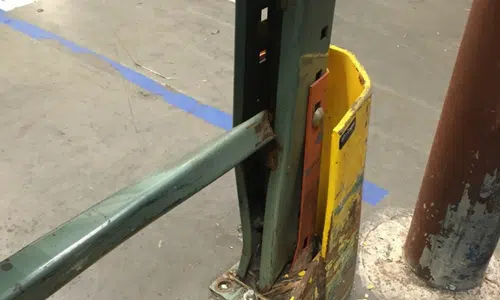
Pallet Rack Safety Clips
Most modern pallet rack beams come with built-in safety clips that keep beams locked into upright frames. These clips are important because, without them, friction and the force of gravity would be the only things holding beams in place — no match for the upward force of a lift truck. For beams without built-in clips or beams whose clips are gone, we highly recommend installing pallet rack safety clips.
When to Replace Pallet Racking
If and when a frame becomes damaged, the decision will need to be made whether or not it needs to be replaced. If the frame exceeds the out-of-straight ratio of 1/2” per 10’, it will need to be addressed. We almost always recommend replacing the entire frame when this happens, as opposed to buying a repair kit for the damaged frame.
Pallet Rack Height-to-Depth Ratio
Per RMI standards, the height of a pallet rack system shouldn’t exceed 6 times its depth. In other words, a 36” deep frame shouldn’t be taller than 18’. Any taller than this and the application would need to be reviewed by the manufacturer’s engineer. Fortunately, most pallet racking available to end users falls within this ratio.
Wire Decking
Wire Deck Load Capacities
Wire decking can increase warehouse safety in a number of ways. It improves fire safety by allowing sprinklers to reach the floor, increases air circulation, and allows forklift operators to see loads better, to name a few. Like pallet racking, however, wire decks are rated at a very specific capacity. Exceeding the rated capacity for a wire deck or loading it with anything other than a uniformly-distributed load (UDL) can result in failure.
Examples of loads that are not UDLs include line loads, concentrated loads, and point loads. For more information on proper loading of wire decks, we encourage you to read our article on wire decks and load distribution.
Machine Perimeter Fencing
Machine perimeter fencing is not only a material handling safety best practice, it’s also an OSHA requirement. The purpose of machine perimeter fencing is straightforward: to reduce accidents by reducing the amount of unnecessary traffic around machines. If your facility houses potentially dangerous machinery that’s in an open area, machine perimeter fencing of some type or another is usually recommended. This way, only authorized personnel can breach the machine perimeter.
Flue Spaces
Transverse vs Longitudinal Flue Space
Flue spaces are vertical spaces within pallet rack systems in which ventilation can occur in the case of a fire, and can also be used to create space between racking and any surrounding equipment. In a warehouse storage application, there are two types of flue spaces: transverse and longitudinal. Transverse flue spaces are the spaces that run parallel to upright frames and perpendicular to the length of the row. Longitudinal flue spaces, on the other hand, are the space in between rows of pallet rack. As their name suggests, longitudinal flue spaces are the longer of the two. To be code compliant, both transverse and longitudinal flue spaces must be maintained in the warehouse. One of the most common ways of maintaining code-compliant flue spaces is by using flue spacers.
Flue Spacers for Pallet Racking
Pallet rack flue spacers work by keeping loads out of designated flue spaces. Flue spacers come in a variety of shapes and sizes, but all serve the same function and achieve their goals by keeping loads from encroaching on flue spaces. Pallet stops are often used for keeping loads from sliding off the rear side of pallet racking and into a flue space. Transverse flue spacers may be used to keep loads a certain distance from upright frames, or they may be used to separate the loads themselves. In either case, the minimum transverse flue space is kept unobstructed.
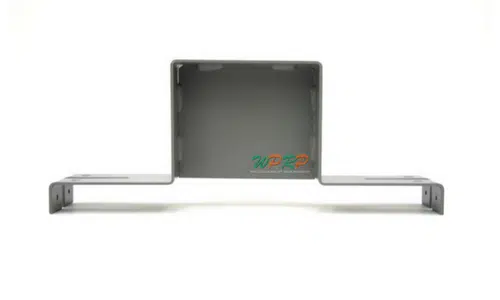
Work Platforms and Mezzanines
Safety Gates and Safety Guardrail
Mezzanines and work platforms can increase the available space in your existing warehouse, making your operations more efficient and saving money over time. Being an elevated platform, they also bring with them an inherent risk of falling. To mitigate this risk, businesses often use safety gates and guardrails.
Safety gates are features of mezzanine guarding that are designed to allow safe access to mezzanines and work platforms. Generally, this means allowing the passage of equipment, inventory, and personnel while minimizing opportunities for falling.
Likewise, safety guardrail is designed to keep personnel and equipment from falling off the mezzanine. Failure to have proper guardrail in place can result in OSHA noncompliance and is required for the overall safety of the mezzanine.
Because of the complexity of mezzanines and the variances in state and local codes, we recommend consulting an experienced material handling outfitter if you have any questions regarding a future or existing mezzanine platform.
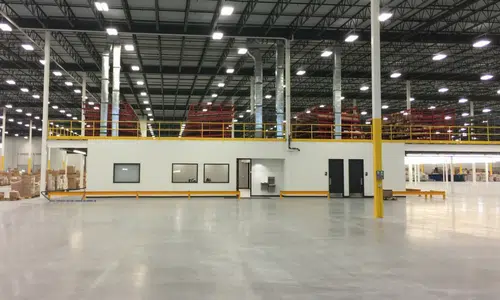
Do you have questions about warehouse safety or items you think we should add to our list? Let us know! We’re always looking to share our knowledge and learn from others when it comes to safety best practices. We look forward to seeing you back for more useful material handling information and industry news.


